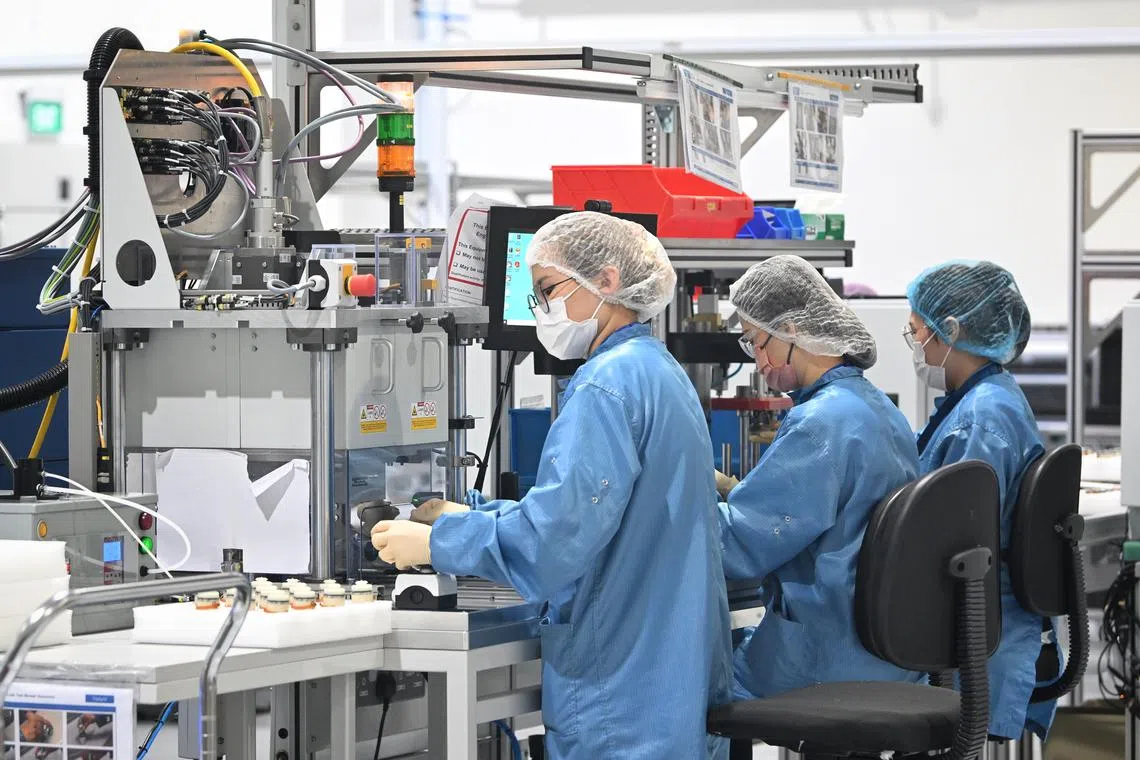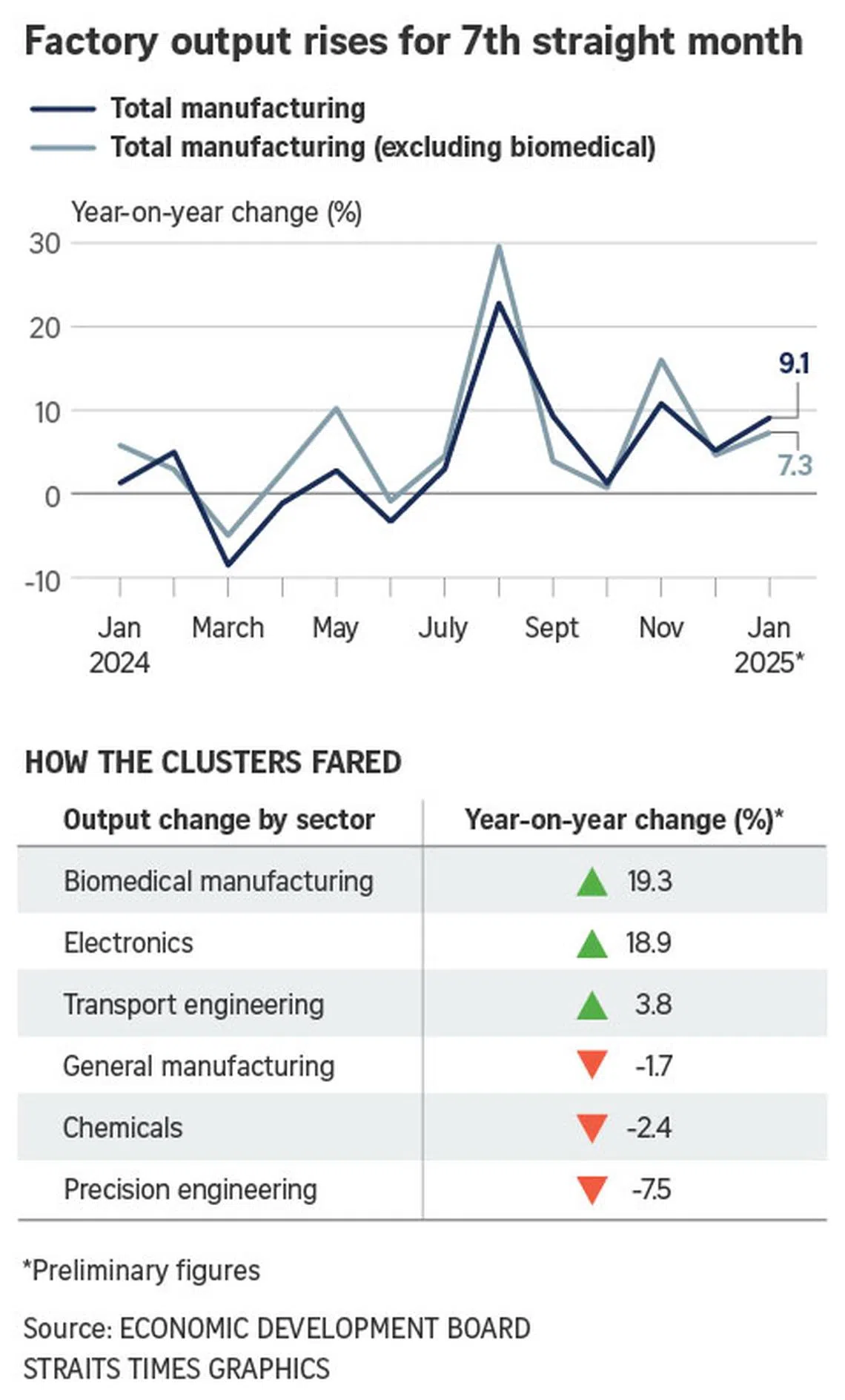Singapore factory output grows 9.1% in January
Sign up now: Get ST's newsletters delivered to your inbox

The expansion came after a revised 5.2 per cent increase in December and a 10.8 per cent rise in the month before that.
PHOTO: ST FILE
Follow topic:
SINGAPORE – Factory production in Singapore rose for a seventh straight month in January, with local manufacturers expressing positive business sentiment for the first half of 2025 despite global uncertainty.
Total output expanded 9.1 per cent year on year, after a revised 5.2 per cent increase in December and a 10.8 per cent rise in the month before that.
Excluding the more volatile biomedical industry, output increased 7.3 per cent, according to data from the Economic Development Board on Feb 26.
On a seasonally adjusted month-on-month basis, manufacturing output increased 4.5 per cent. Excluding biomedical manufacturing, output increased 4.2 per cent.
Biomedical manufacturing output grew the most, rising by 19.3 per cent year on year. Output in the pharmaceuticals segment rose 33.6 per cent, on account of a different mix of active pharmaceutical ingredients being produced and higher production of biological products compared with a year ago.
Conversely, the output of the medical technology segment declined 3.5 per cent owing to lower export demand for medical devices.
The electronics industry, which accounts for nearly half of Singapore’s manufacturing output, saw an increase of 18.9 per cent in January year on year, after the revised 3.1 per cent rise in December.
Within the cluster, infocomms and consumer electronics surged 47.8 per cent, while semiconductor production grew 17.9 per cent. Other electronic modules and components fell 15.9 per cent, due in part to weakness in the global automotive industry, but computer peripherals and data storage expanded 15.4 per cent.
Output in the transport engineering sector climbed 3.8 per cent in January year on year, with all segments recording output growth.
The aerospace segment led the charge, growing 5.2 per cent on account of increased maintenance, repair and overhaul jobs from commercial airlines. The land segment rose 1.4 per cent, while the marine and offshore engineering segment grew 0.6 per cent.
General manufacturing output fell 1.7 per cent in January compared with the same month in 2024. The food, beverages and tobacco segment expanded 7.5 per cent, led by higher production of beverage concentrates and milk powder.
Conversely, the printing segment fell by 8.8 per cent, while the miscellaneous industries segment declined by 13.8 per cent, recording lower production of structural metal products, apparel, and paperboard containers and boxes.
The chemicals segment’s output declined 2.4 per cent in January compared with a year ago. The petroleum and other chemicals segments grew 7.2 per cent and 0.5 per cent, respectively.
Conversely, the petrochemicals segment declined 3.9 per cent and the specialties segment by 19.4 per cent, with the latter recording lower production of mineral oil additives and biofuels.

Production in the precision engineering cluster contracted 7.5 per cent in January on a year-on-year basis, with all segments registering output decline.
Within the cluster, the precision modules and components segment declined 3.6 per cent, led by lower output in metal precision components, dies, moulds, tools, jigs and fixtures. The machinery and systems segment declined 8 per cent on account of lower production of semiconductor equipment, measuring devices and process control equipment.
DBS Bank economist Chua Han Teng said new export orders, new orders and order backlogs signal resilient near-term external demand for Singapore’s manufactured goods.
“The ongoing global tech upcycle, supported by robust growth of artificial intelligence applications for consumer devices, should benefit Singapore’s electronics factories in the near term,” he said.
A possible further rush to front-load export orders ahead of the actual implementation of additional US tariffs on targeted trading partners of the country could bolster Singapore’s manufacturing growth in the near term, said Mr Chua.
“(However), a wider global trade war and increased trade policy uncertainty present medium-term challenges and downside risks to highly trade-dependent Asian economies, including Singapore,” he said.
While 2025 is off to a good start, whether this momentum is sustainable for the rest of the year remains to be seen, noted OCBC Bank chief economist Selena Ling, as US tariffs continue to be touted, with the net widening to include reciprocal tariffs.
Rosalind Ang is a business journalist who has been with The Straits Times since 2021. She covers e-commerce and stories on retail businesses.

